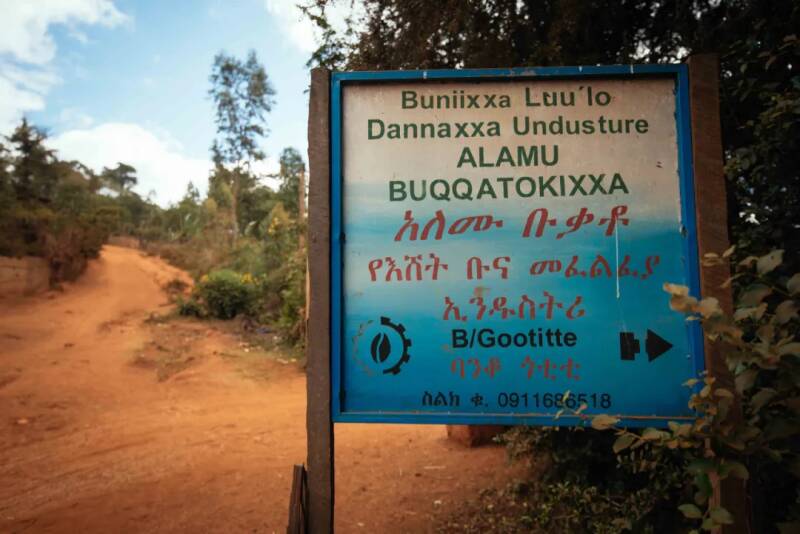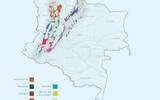The difference between Guodin and Yejia Xuefei is Ethiopia Guodin a production area? Is Guodin produced in Kocher or Godibe?
Yirgacheffe originally belonged to the sub-region of sidamo, Ethiopia, but the flavor of its washed coffee beans was so outstanding that it became a large producing area. Elegant white flower aroma, bright lemon fruit flavor, fresh green tea tail, this is the "Yejia Xuefei flavor" handed down by the coffee population. But did you know that when talking about Yega Xuefei, most people can't get around a bean-"Guoding Ding". "Godding", which is a playful and interesting name. When many friends are not deeply involved in coffee, they will be attracted by its name, and then order a cup to feel whether it is as playful as the name.
Qianjie believes that like the guests who visited yesterday, although they have known Guodingding for a long time, they do not know whether the name refers to the bean seed or the place of origin. Then there was a dramatic scene. This friend went directly to surf the Internet to search for answers, and found such a result!
Emmmmm... So today, Qianjie will come to share with you, Guo Dingding, what exactly does it mean?
What is Guoding Ding? In fact, Gotiti is not any producing area, the name of any bean, it is a cooperative, but also a small village. It is much younger than the established co-operatives that have been around for decades, because Guotingding was founded in 2012.

The Guodingding Cooperative is located in the small town of Gedeb in the southeast corner of the Yirgacheffe producing area, about 60 kilometers away from the town of Yejashefi. According to the division of production areas by the Ethiopian Commodity Exchange, Godibe is actually part of the Kochere producing area, while if it is divided by administration, Godibe exists at the same administrative level as Cochell. (map of Cochell)
Bet without prize! Does Guodingding belong to the Godibe producing area of Yega Sheffield or Kochel of Yega Sheffield?

Announce the answer: driven by the traceability of boutique coffee, Godibe successfully separated from Cochell, that is to say, the Godibe co-operative belongs to the sub-producing area of Godibe, which belongs to Yegashifi.
On the other hand, the average elevation of Godibe producing area is higher, about 1900-2200 meters. The high altitude delays the ripening time of the coffee, so the coffee can accumulate more delicacy. One reason why many small producing areas are independent of the traceability of fine coffee is that they believe that their coffee is comparable to that of large producing areas. It is because of this that the more than 300 farmers who make up Guotintin broke away from the Waka Cooperative under the YCFCU of the Yega Sheffield Alliance and set up the Gottingding Cooperative.
What is a cooperative? The coffee fruit will be treated after it is harvested to remove the peel, pulp and other substances other than beans. And the place where these fruits are processed is the processing plant. However, because the handling of coffee fruit has higher requirements for venues and equipment, many farmers cannot afford to buy even if they use all the money for selling beans. What are we going to do?
Some farmers will choose to ship the harvested fruits to nearby processing plants and hand them over to others for processing. And this will lead to the intervention of many middlemen, depressing the purchase price of the fruit and reducing the income. Therefore, in order to reduce the price difference earned by middlemen, farmers in an area will raise money to set up a processing plant together. Then, such a treatment plant will be named after the local name, for example, if Banko Gotiti treatment plant, the source is the name of the local village: banke Tintin (Gotiti for short). After the establishment of the cooperative, farmers can send the fruit to the processing plant for processing, and then dock directly with exporters without having to earn too much price difference by middlemen. Beans produced by the Guodingding Cooperative will also be named after "Guoding Ding". So there will be friends here to ask: since it is not the name of the bean seed, then what is the bean seed of Guoding?
What is the bean seed of Guoding Ding? What we need to know is that the vast majority of coffee grown in Yejassefi belongs to the pastoral model, and the coffee produced in this model has a nickname: "pastoral coffee". Guoding coffee belongs to this type. The so-called pastoral coffee means that farmers will plant coffee trees in their fields or living areas, then pick them themselves and send them to the treatment plant for unified treatment. The planting area of the Guodingding Cooperative is about 760 hectares. On average, the per capita planting area of farmers is about 2 hectares, with an annual output of nearly 460 tons.
Since there are thousands of varieties of coffee in Ethiopia, the same is true of beans planted by farmers. Most processing plants do not distinguish between varieties, but directly mix them together, so generally speaking, coffee beans produced by most cooperatives are summarized using "Heirloom" (native species). It is worth mentioning that because no chemical fertilizers are used in the planting process, the coffee produced by the Guotintin Cooperative has also been certified as organic coffee by the European Union. Because the members of the Guodingding Cooperative originally belonged to the Waka Cooperative, they had plenty of experience in coffee processing, especially washing treatment. As a result, they use washed coffee beans to perform very well!
Briefly introduce the washing treatment: after harvest, coffee cherries will be floated to pick out bad fruit; then the selected beans will be peeled by machine to remove the skin and pulp; then the raw beans with part of the pulp and pectin will be thrown into the water for fermentation, which can be removed and cleaned in about 24 hours. After cleaning, the drying step of sunshine can be carried out to reduce the moisture content of beans to about 12%. Finally, the parchment paper is removed and the washing treatment is completed.
On the other hand, washing gives the fruit dingding a very high cleanliness, the flavor is more obvious, and the characteristics are more distinct. Because it is very classic, Guodingding has always been a resident food rations in the front street. In order to better let the beans show the characteristic flavor of Yega Xuefei, Qianjie used a light baking to "cook" the fruit.
Qianjie Coffee: Ethiopia Fruit Tintin country: Ethiopia producing area: Yega Sheffield Godibe: altitude: 1900-2200m varieties: original seed treatment method: washing grade: G1 flavor: lemon, berries, white flowers, green tea
The front street uses a hand-made way to taste the delicacy of a pint of dingding! In the aroma, we can smell a hint of flowers and a little sour berries. In the taste, the fruit shows a very fresh sweet and sour lemon, white flowers, as well as green tea tail. The taste is light, the cleanliness is very high, and I deeply feel the unique charm of "Yejia Xuefei".
-END-
Important Notice :
前街咖啡 FrontStreet Coffee has moved to new addredd:
FrontStreet Coffee Address: 315,Donghua East Road,GuangZhou
Tel:020 38364473
- Prev

U.S. warships under attack! Situation in the Red Sea will continue to affect coffee trade
According to media reports, three U.S. warships in the Red Sea region were recently attacked by missiles and drones fired by Houthi armed forces in Yemen. The U.S. military said it intercepted them. According to U.S. officials, this was one of the largest attacks to date on U.S. warships operating in the Middle East. It is reported that the Houthi armed forces have sent troops to the United States
- Next

In what producing areas are coffee mainly grown in Colombia? What are the characteristics of the coffee produced?
South America is the continent with the largest coffee production in the world, producing more than half of the world's coffee production every year. It also has Brazil, which has the world's largest coffee production, and Colombia, which has the world's third largest coffee production. Colombia is the world's leading Arabica producer, but unlike Brazil's large plantations, Colombia
Related
- What effect does Italian American coffee with filter paper have? Will coffee taste better if it is put on filter paper at the bottom of the powder bowl?
- What is the color difference in coffee beans? What are the characteristics of honey processed coffee beans? Why are the anaerobically treated coffee beans uneven in color?
- How does novice Xiaobai quickly get started and make coffee? Newbies learn to make coffee by hand and share the specific steps and process process!
- Costa tea has a shelf life of 100 years?! Expert: Unable to verify
- It's a huge uproar! American milk addition was rejected by Manner employees?!
- Mocha pot coffee bean recommendations| How fine and how much powder should be used for grinding? What parameter ratios do I need to use to make milk with Mocha pot coffee?
- What are the characteristics of the world's top ten coffee beans treated with Costa Rica honey? How to make black honey kadura from Tarazhu Pilon Processing Plant taste good?
- How to make deep-roasted coffee? What grinding water temperature does authentic Jamaica Blue Mountain No. 1 coffee use to brew it well?
- Selected high-grade rose summer coffee flavor tasting guide Why Panama rose summer has the aroma of flowers and fruits
- What equipment does a novice Xiaobai need to buy to learn to make coffee? Filter cup electronic scale bean grinder manual flushing pot purchase guide

